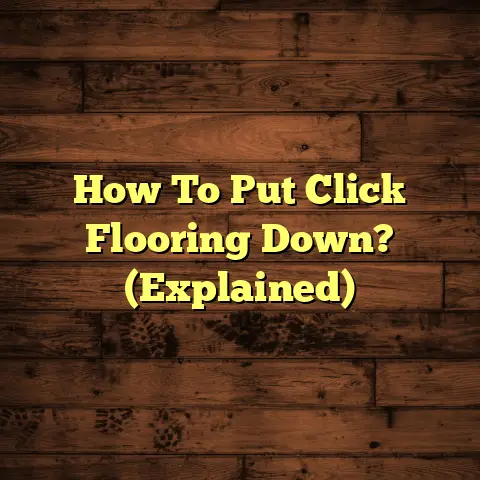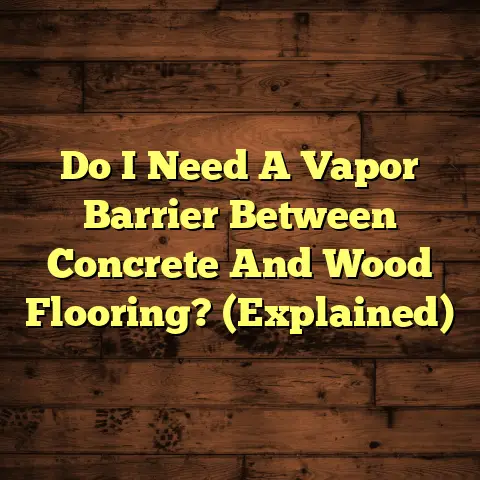Types of Siding: What To Know? (4 To Avoid!)
Have you ever driven down a street and felt instantly drawn to a particular house?
Maybe it was the cozy glow from the windows, the perfectly manicured lawn, or perhaps it was the siding that just spoke to you.
Our homes are more than just brick and mortar; they’re the backdrop to our lives, the safe havens where we build memories with loved ones.
I remember one Thanksgiving at my own house, the aroma of turkey filling the air, laughter echoing through the rooms.
The warm, inviting exterior, clad in classic siding, felt like a hug welcoming everyone home.
But let’s be real, choosing the wrong siding can turn that dream home into a headache.
Imagine dealing with constant repairs, unsightly damage, or even safety concerns because of a bad siding choice.
Nobody wants that!
So, are you ready to explore the world of siding and make sure your home looks and feels its best?
Let’s dive in!
Section 1: Overview of Siding
So, what exactly is siding?
Well, in simple terms, it’s the protective skin of your house.
Think of it as the first line of defense against the elements.
Siding’s main jobs are to shield your home from rain, wind, snow, and sun, all while keeping it insulated and looking great.
But it’s not just about protection.
Siding also plays a huge role in the overall look and feel of your home.
It’s what people see first, and it can make or break your home’s curb appeal.
Over the years, siding materials have come a long way.
Back in the day, options were limited, but now, thanks to modern advancements, we have a whole spectrum of choices.
From traditional wood to high-tech composites, there’s a siding option for every style and budget.
And speaking of curb appeal, it’s not just about aesthetics.
A well-maintained exterior can significantly boost your home’s value.
In fact, according to the National Association of Realtors, good curb appeal can add up to 7% to your home’s perceived value! https://www.nar.realtor/
Plus, a beautiful home makes you feel good, right?
It’s about taking pride in your property and creating a welcoming space for yourself and your neighbors.
Section 2: Types of Siding
Alright, let’s get into the nitty-gritty and explore the different types of siding out there.
1. Vinyl Siding
Vinyl siding is like the reliable friend who’s always there for you.
It’s made from PVC (polyvinyl chloride) plastic and comes in a variety of styles, from traditional horizontal panels to vertical boards and even shakes.
One of the reasons vinyl siding is so popular is its affordability.
It’s generally less expensive than other options like wood or brick.
Plus, it comes in a rainbow of colors, so you can easily find something that matches your taste.
Pros:
- Low maintenance: Just wash it down with a hose every now and then.
- Durability: It can withstand harsh weather conditions.
- Affordability: Budget-friendly option.
Cons:
- Fading: Colors can fade over time, especially in direct sunlight.
- Environmental concerns: PVC production can have environmental impacts.
- Can look “plasticky”: Some find it lacks the natural look of other materials.
2. Wood Siding
Ah, wood siding, the epitome of natural beauty.
There’s just something about the warmth and character of wood that’s hard to beat.
You’ve got options like cedar, redwood, pine, and even plywood.
Each type has its own unique grain pattern and color variations.
But with great beauty comes great responsibility.
Wood siding requires regular maintenance to keep it looking its best.
We’re talking about staining, painting, and sealing to protect it from the elements.
Pros:
- Natural beauty: Unmatched warmth and character.
- Versatility: Can be stained or painted to match any style.
- Eco-friendly: A renewable resource (when sourced responsibly).
Cons:
- High maintenance: Requires regular painting or staining.
- Susceptible to pests: Termites and other insects can cause damage.
- Water damage: Can rot if not properly protected.
3. Fiber Cement Siding
Fiber cement siding is like the superhero of the siding world.
It’s made from a mixture of cement, sand, and cellulose fibers, which makes it incredibly durable and resistant to just about anything.
Fire? No problem. Pests? Not a chance. Extreme weather? Bring it on!
Plus, fiber cement siding can mimic the look of wood, stucco, or even brick, so you get the best of both worlds.
Pros:
- Durability: Resistant to fire, pests, and rot.
- Versatility: Can mimic the look of other materials.
- Low maintenance: Requires minimal upkeep.
Cons:
- Installation costs: Can be more expensive than vinyl siding.
- Weight: Heavy material, which can make installation more challenging.
- Can crack: Though durable, it’s not immune to cracking under stress.
4. Stucco Siding
Stucco siding is like a trip back in time.
It’s been used for centuries, especially in warm, dry climates.
Stucco is a cement-based plaster that’s applied in layers to create a textured surface.
It’s known for its energy efficiency and longevity, but it requires a skilled application to prevent cracking.
Pros:
- Energy efficiency: Helps keep your home cool in the summer and warm in the winter.
- Longevity: Can last for decades with proper maintenance.
- Unique texture: Adds character and charm to your home.
Cons:
- Cracking: Prone to cracking, especially in areas with seismic activity.
- Skilled application: Requires experienced professionals to install properly.
- Moisture damage: Can be damaged by excessive moisture if not properly sealed.
5. Metal Siding
Metal siding is like the modern, sleek cousin of traditional siding.
It’s known for its durability, fire resistance, and contemporary look.
You’ve got options like aluminum and steel, each with its own set of benefits.
Aluminum is lightweight and rust-resistant, while steel is incredibly strong and can withstand high winds.
Pros:
- Durability: Long-lasting and resistant to damage.
- Fire resistance: A safe option for homes in fire-prone areas.
- Modern look: Adds a sleek, contemporary touch to your home.
Cons:
- Denting: Can be dented by hail or other impacts.
- Rusting: Steel siding can rust if not properly coated.
- Thermal conductivity: Can transfer heat and cold more readily than other materials.
6. Brick and Stone Siding
Brick and stone siding are like the timeless classics that never go out of style.
They exude elegance, durability, and a sense of permanence.
These materials offer natural insulation and require minimal maintenance.
However, they come with a higher price tag and labor-intensive installation.
Pros:
- Durability: Extremely long-lasting and resistant to damage.
- Low maintenance: Requires minimal upkeep.
- Natural insulation: Helps regulate your home’s temperature.
Cons:
- High cost: More expensive than other siding options.
- Labor-intensive installation: Requires skilled masons.
- Limited color options: Natural colors can be limiting for some homeowners.
Section 3: What To Avoid: Four Types of Siding to Be Cautious Of
Alright, now that we’ve covered the good stuff, let’s talk about the siding options you should approach with caution.
1. Asbestos Siding
Asbestos siding is like a wolf in sheep’s clothing.
It was popular in the mid-20th century for its fire resistance and durability.
But now we know that asbestos is a serious health hazard.
When asbestos fibers are inhaled, they can cause lung cancer, mesothelioma, and other respiratory diseases.
If you have asbestos siding on your home, don’t panic.
But it’s crucial to have it inspected by a professional and removed safely.
Why avoid it?
- Health risks: Asbestos fibers are carcinogenic.
- Legal issues: Many areas have strict regulations regarding asbestos removal.
- Devaluation: Can significantly decrease your home’s value.
2. Cheap Vinyl Siding
Cheap vinyl siding is like a fast-fashion outfit – it looks good at first, but it doesn’t hold up over time.
Low-quality vinyl is prone to warping, fading, and cracking.
It can also be more susceptible to damage from impacts and extreme weather.
Sure, it might save you some money upfront, but you’ll end up paying more in the long run with repairs and replacements.
Why avoid it?
- Short lifespan: Doesn’t last as long as higher-quality vinyl.
- Warping and fading: Loses its appearance quickly.
- Poor insulation: Doesn’t provide adequate protection against the elements.
3. Unfinished Wood Siding
Unfinished wood siding is like leaving your skin unprotected in the sun.
Without proper treatment, wood is vulnerable to rot, pests, and water damage.
Untreated wood can quickly become a breeding ground for mold and mildew.
Plus, it can attract termites and other insects that can wreak havoc on your home’s structure.
Why avoid it?
- Rot and decay: Quickly deteriorates without protection.
- Pest infestations: Attracts termites and other wood-boring insects.
- Water damage: Absorbs moisture and can lead to structural problems.
4. Subpar Fiber Cement
Subpar fiber cement is like a knock-off version of a designer product.
It might look similar on the surface, but the quality is nowhere near the same.
Inferior fiber cement can be prone to cracking, crumbling, and moisture absorption.
It’s essential to choose a reputable brand with a solid warranty to ensure you’re getting a quality product.
Why avoid it?
- Cracking and crumbling: Doesn’t hold up well over time.
- Moisture absorption: Can lead to water damage and mold growth.
- Poor warranty: May not be covered if problems arise.
Conclusion: Empowering Homeowners
So, there you have it – a comprehensive guide to the world of siding.
I hope this has given you a better understanding of the different types of siding available and what to avoid.
Remember, choosing the right siding is an investment in your home’s future.
Consider not just aesthetics but also long-term maintenance, safety, and environmental impact.
Your home is your sanctuary, the place where you create memories and build your life.
Choosing quality siding is a great way to protect that sanctuary and ensure it remains a welcoming and beautiful space for years to come.
So, take your time, do your research, and choose wisely!





